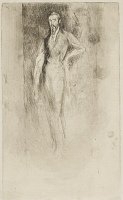Etchings Institutions search term: grolier club
F. R. Leyland | ||
| Number: | 121 | |
| Date: | 1874/1875 | |
| Medium: | etching, drypoint and open bite | |
| Size: | 304 x 177 mm | |
| Signed: | butterfly at right | |
| Inscribed: | no | |
| Set/Publication: | 'Cancelled Plates', 1879 | |
| No. of States: | 2 | |
| Known impressions: | 20 | |
| Catalogues: | K.102; M.103; W.93 | |
| Impressions taken from this plate (20) | ||
KEYWORD
TITLE
'F. R. Leyland' (1886, Frederick Wedmore (1844-1921)). 3
3: Wedmore 1886 A (cat. no. 93).
DESCRIPTION
SITTER
The oil portrait, reproduced below, was painted between 1870 and 1874, and was exhibited in Whistler's one-man exhibition in London in 1874.
4: Colby College Museum of Art, Freer Gallery of Art; r.: Portrait study of Frederick R. Leyland; v.: Head of a boy [m0425], Portrait of Frederick R. Leyland [m0426], Metropolitan Museum of Art.
5: California Palace of the Legion of Honour; Ashmolean Museum; also Caricature of F. R. Leyland [m0720] (Hunterian) and F. R. Leyland [m0721] (Glasgow University Library).
Oil on canvas,
Freer Gallery of Art, Washington DC.,
Gift of Charles Lang Freer, Acc. No. F1905.100a-b.
6: A. M. Whistler to M. G. Hill, [8-]10 September [1870], GUW #07642.
7: Pennell 1908 , vol. 1, p. 176.
DISCUSSION
8: Lochnan 1984 , p. 159.

